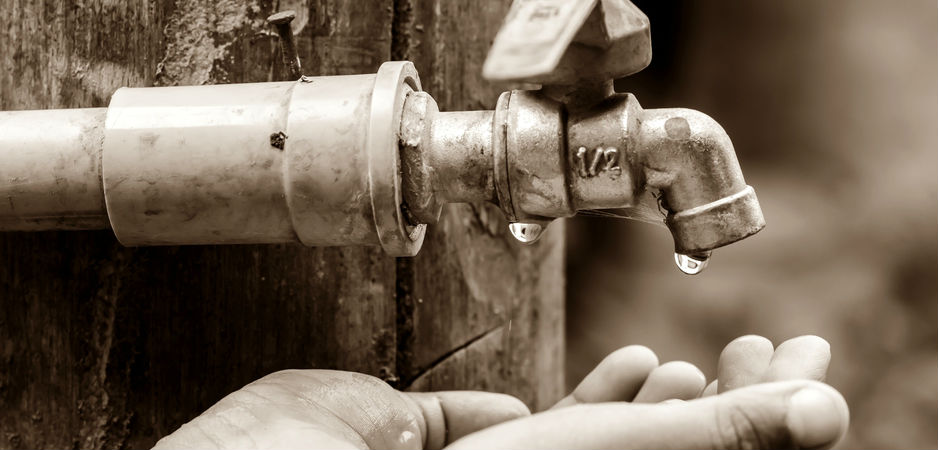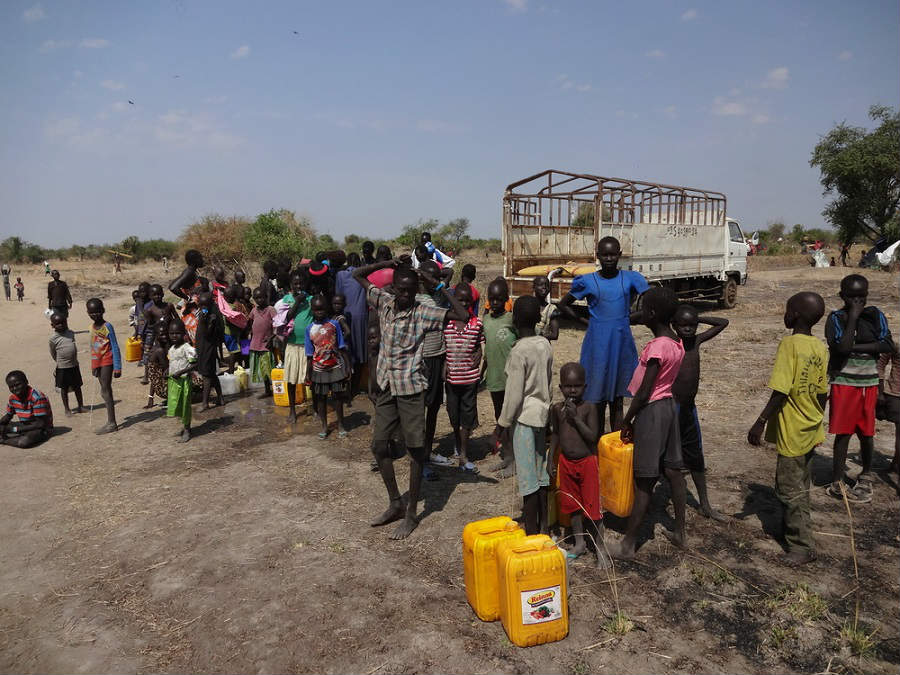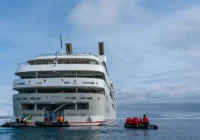The depletion of freshwater resources will inevitably lead to tension, conflict and migration among large swathes of the world’s population. [Click the image above or scroll down to view the mini gallery.]
Yemen, an impoverished desert country racked by years of conflict, instability and misgovernance, may soon add another dubious distinction to its unfortunate track record: At current rates, it may become the first country in the world to run out of water. With apocalyptic gloom, experts have put 2025 as the date when the country’s capital, Sana’a, home to nearly 2 million residents, runs dry. The majority of Yemen’s water resources are used for agricultural purposes – a staggering 40% being used to grow khat, a mild stimulant chewed by many Yemenis.
Yemen is not alone. Many other countries through geographic ill-fate, climate change or water mismanagement are facing looming water shortages. It is estimated that 1.2 billion people, mostly in arid and semi-arid regions of the Middle East and Africa, live in regions where water is a physical scarcity. The acute lack of water will exacerbate existing problems (poverty, food security, environmental sustainability, socioeconomic and ethnic tensions), sow instability, provide the impetus for mass migration and may eventually lead to armed conflict.
A 2012 report on Global Water Security from the United Sates Director of National Intelligence stated that the demand for water would lead to an increased risk of conflict in the future. The Pacific Institute, which tracks water-related conflicts, reiterated this pessimistic diagnosis when it reported an increase in the number of violent confrontations that have recently occurred over water.
Adapting to water scarcity can be a difficult task that places immense pressure on struggling governments in the developing world. This is why many analysts predict that if conflict does erupt over water, it is much more likely to be localized intrastate armed conflict rather than traditional interstate one. This is all too true in Yemen, where researchers have found that between 70-80% of rural conflicts are the result of water-related disputes.
The future shortage of water has led to Malthusian predictions about the ability of states to combat water shortages. However, without coordinated efforts to tackle the necessary problems, the lack of water can and will lead to destabilization and violent conflict.
Deep Waters
If 71% of the earth’s surface is covered by water, why is the globe suddenly facing a water crisis? For one thing, saltwater oceans make up 97.5% of the water on planet Earth. Freshwater accounts for a minuscule 2.5% of this, 68.7% of which is trapped in glaciers. That leaves 30.1% of the world’s 2.5% freshwater available for human use.
Population increases, along with the accompanying rise in agricultural production necessary to support the world’s 7 billion-plus peoples, have placed an enormous strain on the world’s limited resources. Around 70% of global freshwater consumption, and up to 90% in the developing world, is expended on agriculture, while a sizable portion of the remaining water is used to support industrial activity and energy production. The simple fact is that in many places, water consumption has begun to exceed local water recharge. The World Bank estimates that 2.8 billion people, mostly in the developing world, live in areas afflicted by high water stress, where the demand for water surpasses the supply. This figure will continue to rise as the world’s population balloons to 9 billion by 2050.
A major study by the Water Resources Group found that by 2030, the global demand for water would be 40% above today’s water supply levels. Beyond population growth and its attendant stresses on local water supplies, one of the largest drivers of water scarcity is global warming. A recently released report on the effects of climate change by the Intergovernmental Panel on Climate Change (IPCC) outlined the drastic consequences climate change will have unless preventative action is taken. Rajendra Pachauri, the chair of the IPCC, was dire in his prognosis: “Nobody on this planet is going to be untouched by the impacts of climate change.”
According to the report, environmental degradation and the risk of flooding, which can destroy a season’s crop or contaminate clean water supplies, are expected to increase. In coastal areas, rising sea levels may affect the salinity of fresh ground water, making it potentially unusable for practical use. The ready availability of freshwater resources may also be altered as global warming shifts climate and precipitation patterns leading to drought, desertification and subsequent overuse of existing reserves to cover deficits in the water supply. One example is Sudan, whose population, despite sizable oil reserves, remains largely agrarian. Below average rainfall, land degradation and creeping desertification has led to clashes over limited water supplies.
Inexpensive Luxury
If this weren’t enough, the World Bank believes that water usage in agriculture will double by 2050. The IPCC estimates that crop yields in many at-risk regions will be hard hit as yields of maize, rice and wheat are all expected to decline while demand continues to grow. This, in turn, may lead to a rise in the cost of food and cause serious implications for global food security. The average cost of key staples, like grains and cooking oil, has risen almost continuously over the past decade, reaching a historic peak in August 2012. Price hikes in the cost of water, once an inexpensive luxury, could lead to subsequent increases in the price of basic foodstuffs, creating the potential for widespread conflict and displacement in the developing world.
The expanding industrial sector accounts for 20% of global freshwater withdrawals. Water-intensive industries, like high-tech manufacturing and electric power plants, which account for 39% of freshwater withdrawals in the United States, along with highly irrigated farming and animal hydration, can take a heavy toll on a country’s water supply. The lack of sustainable water policies in many of the world’s poorest countries has made millions of people vulnerable to the slightest disruption in the water supply. In Yemen, for instance, current water usage is five times what are considered sustainable levels.
This would be less of an issue if environmental management were a higher priority around the world. Poor governments are some of the biggest culprits, but they also lack the necessary financial resources or modern infrastructure to effectively adapt to water shortages. Nonetheless, as the recent water shortage in California has demonstrated, the developed world will also be forced to adopt new water standards as reserves begin to wane.
The potential for the contamination of freshwater is also a major issue that has been severely mismanaged in the developing world, where 760 million people lack access to clean water and 2.5 billion people live in unsanitary conditions. Unless action is taken, the Pacific Institute estimates that between 34 and 76 million people, mostly children, will die from water-related diseases by 2020. Both Brazil and India have sizable watersheds that provide freshwater, but due to poor infrastructure, a large portion of it is unsanitary and therefore cannot be used.
Water and Malthus
The UN estimates that, considering current water depletion trends, up to 700 million people may be at risk of forced migration due to water scarcity by 2025. The stark reality is that increased water use due to population growth and climate change means that many of the world’s poorest now live in regions that lack the natural resources necessary to physically support them. “Water refugees” make up just one factor among a litany of potential complications associated with future water scarcity.
The most serious threat of violence breaking out over the access to water is expected to occur at the subnational level. Existing international forums and diplomatic negotiations should enable transnational cooperation between states in regards to water-related issues. However, within poorer, weaker states, where the rule of law is limited, the possibility of localized violence over water has continued to grow.
In 2012, over a hundred people were killed in clashes between farmers and cattle herders, triggered by a dispute over local water sources and grazing rights in the Tana River delta region. The nearby Lower Ormo Valley was the site of a similar encounter in 2006, when 40 people died in clashes between pastoralists and farmers. Water was also the catalyst for violence in India between farmers in Tamil Nadu and Karnataka over the rights to the Cauvery River in a long-standing dispute.
Water, once one of the most reliable resources in the world, has become both a valuable weapon and a military objective during armed conflict. During Libya’s brief civil war, Muammar Gaddafi’s forces shut-off two-thirds of Tripoli’s water supplies, leaving almost half the country short of water. Rebels in the ongoing Syrian Civil War have targeted the water system as part of their struggle against the regime of Bashar al-Assad.
Additionally, terrorists have begun to use water as a tool to sow fear and strike at their opponents. In 2012, insurgents poisoned a well near a girls’ school in Afghanistan in order to punish those receiving an education. A number of wells were poisoned during the conflict in Darfur as part of a campaign to intimidate local residents.
Despite all these difficulties, Thomas Homer-Dixon, a professor at the Balsillie School of International Affairs, claims the greatest prospect of water-related conflict will not be the result of direct hostilities over water itself, but rather it will provide the catalyst for future conflict. In such instances, environmental problems related to water scarcity will exacerbate other factors such as poverty, starvation, ethnic tension, stunted economic growth and poor governance that will escalate into violent hostilities.
One example is in Jordan, which has the third-lowest reserves of water in the world and is faced with a continuing influx of Syrian refugees to feed and care for, putting a strain on its limited resources and creating the potential for the widespread outbreak of violence.
The most salient point is not how violent encounters over water-related issues will emerge, but that they are becoming increasingly likely. Uncertainty over where conflict may break out remains, but the fact that water is an indispensible resource for human existence creates the potential for hostilities to continue and eventually worsen.
Bridges Over Troubled Waters
Bridges over these troubled waters do exist, but it will be up to the international community to prioritize water security. Shortsighted inaction needs to be replaced by the responsible management of natural resources. Good governance, environmental management, local water conservation and efficient usage of water can all help combat scarcity and reverse exploitation of exhausted local resources. Technical know-how and advanced water system knowledge needs to be disseminated to the developing world, while sustainable green technologies should be invested in and explored elsewhere.
Freshwater, though often delineated within national boundaries, is still a collective resource that should be distributed equitably among a state’s population to ensure that sufficient water supplies reach all groups within a state. It is up to both the international community and local governments to take the necessary steps to combat water scarcity before conflict becomes the norm, rather than a rarity. Water is a key to national wellbeing and a resource vital to meet basic human needs. If steps are not taken, water will intensify existing struggles while providing the catalyst for new conflicts.
We bring you perspectives from around the world. Help us to inform and educate. Your donation is tax-deductible. Join over 400 people to become a donor or you could choose to be a sponsor.
The views expressed in this article are the author’s own and do not necessarily reflect Fair Observer’s editorial policy.
Photo Credit: TippaPatt / Wutthichai / Paskee / JPRichard / Shutterstock.com
Support Fair Observer
We rely on your support for our independence, diversity and quality.
For more than 10 years, Fair Observer has been free, fair and independent. No billionaire owns us, no advertisers control us. We are a reader-supported nonprofit. Unlike many other publications, we keep our content free for readers regardless of where they live or whether they can afford to pay. We have no paywalls and no ads.
In the post-truth era of fake news, echo chambers and filter bubbles, we publish a plurality of perspectives from around the world. Anyone can publish with us, but everyone goes through a rigorous editorial process. So, you get fact-checked, well-reasoned content instead of noise.
We publish 2,500+ voices from 90+ countries. We also conduct education and training programs
on subjects ranging from digital media and journalism to writing and critical thinking. This
doesn’t come cheap. Servers, editors, trainers and web developers cost
money.
Please consider supporting us on a regular basis as a recurring donor or a
sustaining member.
Will you support FO’s journalism?
We rely on your support for our independence, diversity and quality.










Comment